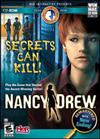Nancy Drew: Secrets
Can Kill, the first Nancy Drew PC game, was released in 1998. Twelve
years and more than twenty games later, the series featuring the famous
detective has been wildly successful. The developer, Her Interactive, has
just released a remastered version of their debut title. Has our intrepid
Ms. Drew changed over the years? How have technological developments
affected the game and gameplay? What follows is a comparison of the old
and new versions, as well as some thoughts as to what type of gamer is
most likely to enjoy the new makeover.
The case in both the original and the remastered
versions has Nancy investigating the death of a student at Paseo Del Mar
High School in Florida. The school is home to the Fighting Manatees
football team, and a star player figures in the game's plot. Amusing
pictures of giant manatees with boxing gloves adorn the walls. Nancy's
Aunt Eloise is the school librarian, and doesn't object to Nancy using her
library key to snoop around while undercover as a new student.
Back to my Old School
My initial impression after playing both games: the
newer version contains significant improvements, especially in terms of
presentation and game mechanics. The viewing area in the original game
takes up only about half the screen. The interface in the original is
downright frustrating in places, forcing the gamer to click repeatedly on
the menu buttons and dialogs to get them to work. It's a challenge just to
locate the "back" arrow in the close-up screens.
In addition, the original game ships on two CDs, and
you have to swap them when you enter different locations. (Remember disk
swapping?) For huge environments, disk swapping might be tolerable. But
Secrets Can Kill has limited environments: a few hallways, a diner,
the school library and a handful of other rooms. Despite the small number
of locations, while playing the original, I swapped the disks almost
twenty times. Near the end, where there's quite a bit of back-and-forthing,
I was swapping every five minutes or so.
The remastered version of Secrets Can Kill,
thankfully, ships on DVD, eliminating the swapping. (A heartfelt "thank
you" to whoever invented DVDs.) The new version has a full screen option
and the interface is much smoother, with consistent "back" arrows and
single click dialogs and menus. The only disappointment --the 360 degree
panning is still somewhat jerky. Voiceovers have been updated -- Lani
Minella voices Nancy in both versions, but in the later version Nancy's
voice has gained nuance and distinctive perkiness. (You can't click
through the dialogs.)
The character models are now in 3D, rather than the
jaggy cartoon characters in the original game. And all kinds of small
improvements have been introduced into Secrets Remastered. For
instance, the fall football season now doesn't occur at the same time as
the May Senior Prom. Nancy is now less impulsive: in the remastered
version, she doesn't actively break the law, or try to corral others into
risking their lives before going to the police. A new character has
surfaced in the later version -- a police detective, who contacts Ms. Drew
after the local law enforcement has been stymied, giving the remade game a
more realistic premise than the original, in which Nancy sneaks into the
school while the official investigation is still proceeding.
The plot is similar in both versions, and the mystery
is well presented, with energizing twists. The characters keep the game
compelling, as they give their opinions of the murder victim, and
unintentionally give information about themselves in the process. The new
version also has a different ending, so playing the original won't spoil
the ending for the remastered version.
The Unexpected
I was surprised to see that some of the
characteristic Nancy Drew elements had developed after the original
version. You can fail in the original, which puts you at the Second Chance
menu, but the chuckle-inducing "you blew it" statements apparently came
later to the series. Much of the puzzling in the original involves
decoding messages, and some of these don't actually figure into the
process of solving the case -- they just add atmosphere. In later games,
virtually every puzzle solution reveals important information or is
applied somewhere -- it isn't merely a contribution to the creepiness
factor. (Some of these coded messages are changed in Secrets Remastered,
and they have been worked into a crucial multi-stepped puzzle.)
The diner in the original game has two arcade video
game machines, but no mini-games that can be played on them! This is
practically a form of apostasy when it comes to Nancy Drew games, which
are now known for their formidable mini-games. (The later version does
provide an optional twitch game, "Barnacle Blast" which is available on
one of the arcade machines.)
Another surprise: compared to later games, the
original Secrets feels quite short. Added together, total playing
time for both versions was about the same as for one recent Nancy Drew
game. It's tempting to speculate about this. The amount of character
interaction is about the same in Secrets as in other games, and the
plot is almost as twisty. Later games have additional content: more
puzzles, mini-games, and more compelling "local color" (information about
the setting or history of the local area). But there's also more
repetition in later games -- time spent trying to drive a car or steer a
boat; time spent swimming through an underwater maze, doing laundry or
preparing meals.
Secrets are Still Deadly
My ostensible purpose for playing both the original
and Secrets Remastered was to advise players of the original
whether playing the newer version is worthwhile. By itself, Secrets
Remastered is a good, though unexceptional game. However, I
particularly enjoyed playing it in conjunction with (and comparing it to)
the original version. If you own the original and are the least bit
curious about trends in the design of these games, play the two versions
together. (It's too bad the original isn't included on the Secrets
Remastered DVD to make it easier to compare them.)
Another reason I particularly enjoyed Secrets
Remastered was its many references to previous Nancy Drew games -- in
library books, in the jukebox music, etc. All of these allusions
contribute to the gamer's enjoyment. But they would be unrecognizable to
someone playing this -- the first game -- as an introduction to the
series.
So if you're a newcomer to the Nancy Drew games, I
wouldn't recommend starting with this one. Since the plot in each game is
self-contained, you should pick a game that has a theme or a location that
happens to intrigue you, and start with that one. If you want lots of
puzzles, start with a game like Last Train to Blue Moon Canyon. If
you'd like to see backstabbing intrigue among students in fancy academic
surroundings, try Warnings at Waverly Academy. If you'd like exotic
environments, try The Phantom of Venice, or if you'd like to be
horrified while snooping around, give Legend of the Crystal Skull a
try.
Once you've played other Nancy Drew games and would
enjoy all the references and allusions in this one, Secrets Can Kill
Remastered is worth your while.
Quick List for Nancy Drew: Secrets Can Kill Remastered
A refashioning of the original Nancy Drew: Secrets
Can Kill, which is more fun for series veterans than for newbies.
Nancy investigates the death of a student and discovers hidden motivations
and dangers. First person perspective, point-and-click interface.
Inventory and decoding puzzles, an optional
mini-game, one slider, no mazes, no sound based challenges. Some codes are
easier to decipher if you can distinguish colors. One fairly difficult
challenge, where you use trial and error to find the right sequence for
pulling levers before time runs out. You can't die, but you can fail. The
game puts you back into the environment before the failure. The most
difficult puzzle -- a coded message with 18 steps. You can play on Junior
or Senior levels.
Somewhat limited environments -- a public high
school, a diner, and a private home. A small cast of characters, a fairly
complicated plot, good voiceovers. No problems with installation; no
glitches. An optional opening tutorial. Unlimited save slots.
Nancy Drew: Secrets Can Kill Remastered is
aimed at fans of the Nancy Drew series -- comparing it to its original
version will interest those with an aptitude for adventure game history.
Final Grade: B
What I played it on:
Dell Studio XPS 8000
Windows 7 Home Premium
Intel Core i5-750 processor
6GB DDR3 SDRAM
1024MB NVIDIA GeForce GT 220
Soundblaster X-Fi
GameBoomers Review Guidelines
September, 2010
design copyrightę
2010
GameBoomers
Group







